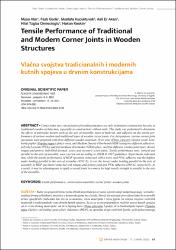Tensile Performance of Traditional and Modern Corner Joints in Wooden Structures

View/
Date
2022Author
Atar, MusaGöde, Fazlı
Küçüktüvek, Mustafa
Akan, Aslı Er
Ömercioğlu, Hilal Tuğba
Keskin, Hakan
Metadata
Show full item recordCitation
Atar, M., Gode, F., Kucuktuvek, M., Akan, A.E., Ormecioglu, H.T., Keskin, H. (2022). Tensile Performance of Traditional and Modern Corner Joints in Wooden Structures [Article@Vlačna svojstva tradicionalnih i modernih kutnih spojeva u drvnim konstrukcijama]. Drvna Industrija, 73 (1), pp. 69-80. https://doi.org/10.5552/drvind.2022.2106Abstract
Corner joints are critical points of wooden structures not only in furniture construction but also in traditional wooden architecture, especially in constructions without nails. This study was performed to determine the effects of particular factors such as the axis of assembly, types of material, and adhesive on the tensile performance of various modern and traditional types of wooden corner joints. For this purpose, various corner joint specimens were prepared with three different wooden materials: Scots pine (Pinus sylvestris Lipsky) wood, Lombardy poplar (Populus nigra Lipsky) wood, and Medium Density Fibreboard (MDF) using two different adhesives: polyvinyl acetate (PVAc) and polyurethane (Desmodur-VTKA) glues; and five different wooden joint types: dowel, tongue-and-groove, half-blind dovetail, screw, and eccentric screw joints. Tensile performance tests, vertical and parallel to the axis of assembly, were carried out according to ASTM D 1037 guidelines. Experiments indicated that, while the tensile performance of MDF specimen connected with a screw and PVAc adhesive was the highest under loading parallel to the axis of assembly (4592 N); it was the lowest under loading parallel to the axis of assembly in MDF specimen connected with tongue-and-groove joint and PVAc adhesive (260 N), respectively. As a result, it may be advantageous to apply screwed joints in corners for high tensile strength in parallel to the axis of the assembly.















